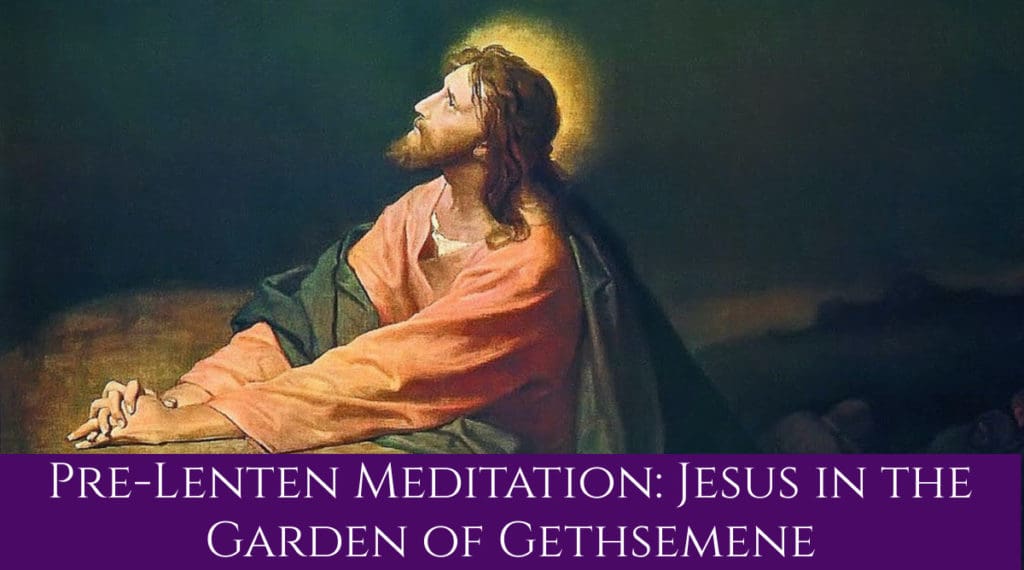Authors Introduction: This is the first of a series of meditations based on the Lenten Votive Masses of the Passion of Jesus that have been prayed throughout the history of the Church in various usages. Some have their origin in early medieval times and were used in various places in Europe and in particular religious orders. Some can be found in the 1955 and 1962 editions of the Missale Romanum. Some parallel prayers can be found in the current English edition of the Roman Missal as well as the Missal of the Holy Land. These meditations are given to offer us an old yet new way to enter into the Passion of Jesus and the salvation He offers us that is rooted in scripture, tradition, and history of the Church. May praying with and reflecting on them help you to grow in Divine Intimacy with Our Lord Jesus and His saving graces this Lenten season and whenever you enter into prayer.
The particular text of the prayers and scripture readings of this mass can be found here.
Opening Collect: Lord Jesus Christ, who by word and example in the garden has taught us how to pray so as to overcome the dangers of temptations: mercifully grant that, ever bent on prayer, we may deserve to reap its plentiful fruit…
At the base of the Mount of Olives in the city of Jerusalem, one can find the Basilica of the Agony – Church of All Nations. This church was built over the Garden of Gethsemane where the passion of Jesus began. In front of the main altar of the Church lays the stone upon which Jesus sweated blood in his agony and where the beginning of the prayer of his Passion would occur. Here at this spot, Jesus was desolate and was tempted. He experienced the depths of the mystery spoken of in the Introit of this mass – Ps. 55 (54): 5-6: My heart is troubled within me, and the fear of death has fallen upon me. Fear and trembling have come upon me.
In the mystery of his Agony, Jesus’ human nature was revolting from the idea of his own suffering and from seeing how profound and oppressive it would be. He still saw the face of God the Father which gave him strength, grace, and focus but he also knew without distraction and in complete purity of thought, our sin, every sin, and the gravity of each sin committed by every person in human history. He would see the souls of the people who would accept his gift of salvation that he would win as well as those who would reject that gift of the debt of sin that he would pay on our behalf for our redemption.
Mark notes that Jesus “took with him Peter and James and John, and began to be greatly distressed and troubled. And he said to them ‘My soul is very sorrowful, (cf. Ps 43[42]:5) even to death; remain here, and watch” (14:33-34) This speaks of the desire that Jesus has to be united to us in loving intimacy in prayer. This is seen in inviting Peter, James, and John to be with him in darkness. This reminds us that we are not to bottle up the darkness and struggles that we face along the way of faith. We are to offer it to the Lord first in prayer, then seek the counsel of others to help us understand it and carry it. (St. Ignatius Loyola, Spiritual Exercises, Rules for Discernment of Spirits -First Week, Rule 13) It also speaks of how when the Lord gives us a particular mission and vocation in our lives for our salvation and the salvation of His Church, we will often face persecution, hostility, and rejection. (Cf. Pope Benedict XVI, Jesus in Gethsemane – February 1, 2012)
In light of the great weight that his human nature was struggling to embrace at that moment, we see Jesus first prostrate himself on the ground – a position that is repeated at ordinations of deacons, priests, and bishops as well as at religious professions. This is a position of complete trust and surrender to God of one’s entire life. We then hear Jesus cry of prayer in his Agony to God the Father, “Father, if you will, remove this chalice from me: but yet not my will, but yours be done.” (Lk 22:42; cf. Mk 14:36) In the Gospel of Mark, Jesus makes the same request of the Father calling him, “Abba.” (Cf. Mk 14:36a) Pope Benedict XVI notes that the term Abba, Father is “the term that children use to address their father and hence that it expresses Jesus’ relationship with God, a relationship of tenderness, affection, trust and abandonment.” Jesus then is showing “in the unity of the divine person of the Son, the human will finds its complete fulfillment in the total abandonment of the I to the You of the Father, called Abba.” (Cf. Pope Benedict XVI, Jesus in Gethsemane – February 1, 2012)
Reginald Garrigou Lagrange describes the nature and meaning of this prayer of Jesus in the Garden in the following way:
“It is a prayer of supplication that expresses a conditional desire, “if it be possible,” a desire dominated by full conformity of the free will with the will of God… Since our Lord had already announced several times that He would be put to death and that He would rise again, He knew very well that this conditional prayer would not be answered. Yet He said this prayer to show that He was truly human and that we are permitted to express the suffering that our nature feels while conforming our will to that of God.” (Our Savior and His Love for Us, 231-232)
If prayer is truly speaking to God as we would a friend, this speaking involves a listening in which there is a personal offering of our life to the will of God. There is also an invitation given by God in prayer to unite His life through grace our own joys and trials that we are facing. Mature, authentic prayer is never one-sided. It always involves an enduring relationship where I become vulnerable before the Lord in good times and in bad through which I am drawn into the mysteries of the life of Jesus in my own life. For any relationship to last, there must be a free, total giving of self. This implies a particular order to this relationship where I invest my time, and I am willing to receive and listen before I ask for what I need, even in times of difficulty and when I am in the agony of desolation or temptation. If prayer is not rooted in the cries of my heart in which I abandon myself in my needs and desires to the Father in the present moment, then it risks becoming superficial and self-seeking. I then can miss the promptings of the aid and inspirations that the Lord is giving me to draw me into His heart and to help me follow him. If I do not pray for perseverance as Jesus did, I can even be lost on the way in my own sin, wounds, and anxieties concerning things that are beyond my ability to control. Fr. Donald Haggerty speaks of this challenge especially when we face interior darkness and uncertainty of what God is asking of us in life:
To remain uncertain for a time after a conversion about what God wants from us, unsure of his desire, may be spiritually preferable, despite the lack of peace it brings, to an easy confidence that all is well and no questions need be asked. It takes courage to consider that the path in which we seem securely placed is not necessarily the choice God would make for us if he were consulted. Many times we may find that praying in a more direct and personal way the internal words of Jesus – “not my will but yours be done” (Lk 22:42)- is followed soon by intervention in our life that shakes our complacency. Forsaking in prayer our own will, choosing intensely to surrender to his will, is never an act without consequence. What follows in life is never by chance or coincidental. The prayer in effect invites God to draw close, to come near, to reassert his unmistakable presence. We should not be surprised that he then does so. Yet he reveals himself invariably in disguise, always leaving us capable of missing his quiet word if we are not ready and longing for it. (Conversion, 115)
Jesus’ prayer in the Agony of the Garden shows His identity both as Beloved Son of the Father and Eternal High Priest. As a priest, he offers sacrifice in humble loving obedience by surrendering this desolation, trials, and temptations through prayer. These are his “strong cries, tears, and supplications” that he offers to the Father in “obedience” and “reverential” love. (Cf. Heb 5: 7-8) This is made evident by the Angel appearing alongside him in the Agony to strengthen him. (Cf. Lk 22:43) This is evidence of how in prayer, even when it’s made in trial, darkness, and desolation, God gives me the grace I need for my salvation and to be faithful to his will. Such a trial is an invitation by the Lord to enter deeper into his heart, by being humble, trusting in his grace, and utilizing what he has given me to be faithful to the vocation he has called me to embrace. (Saint Ignatius of Loyola, Spiritual Exercises – Rules of Discernment – First Week, Rule 9 )In his agony, Jesus is “made perfect by what he suffered,” not that he lacked anything or had sin, but in the sense that He fulfilled the purpose for which the Father ordained him to fulfill from all eternity, which is to embrace the passion of the Cross for our salvation. (Benedict XVI, Jesus of Nazareth – Holy Week, 162-166) This same mystery is what every priest extends to us in the Eucharist every time he consecrates the Eucharist in persona Christi at every Mass which extends to us the Sacrifice of Jesus on the Cross and His enduring presence with His Church.
Every member of the baptized is invited to participate in this same mystery by uniting their lives to Jesus both in the Eucharist at Mass and in the embrace of daily prayer, no matter what they may be facing in the current season of their lives.
Considering the Prayer of Jesus in His Agony at Gethsemane, we pray that Jesus in the Eucharist at Mass may give us the strength, humility, and courage to cooperate with grace and to entrust ourselves to the will of God in every situation we face. May we be given the courage and love to renew our yes to Him in prayer during this upcoming Lenten season so that we may enter fully into the saving embrace of His Sacred Heart in all things that we face in this life and eternally in heaven.
Opening Collect: Lord Jesus Christ, Who by word and example in the garden has taught us how to pray so as to overcome the dangers of temptations: mercifully grant that, ever bent on prayer, we may deserve to reap its plentiful fruit…
Image: Christ in Gethsemene by Heinrich Hofmann, Public domain, via Wikimedia Commons.




